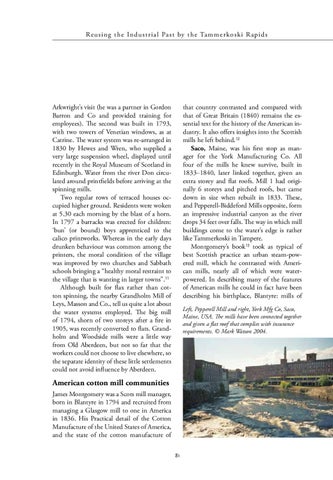Reusing the Industrial Past by the Tammerkoski Rapids
Arkwright’s visit (he was a partner in Gordon Barron and Co and provided training for employees). The second was built in 1793, with two towers of Venetian windows, as at Catrine. The water system was re-arranged in 1830 by Hewes and Wren, who supplied a very large suspension wheel, displayed until recently in the Royal Museum of Scotland in Edinburgh. Water from the river Don circulated around printfields before arriving at the spinning mills. Two regular rows of terraced houses occupied higher ground. Residents were woken at 5.30 each morning by the blast of a horn. In 1797 a barracks was erected for children: ‘bun’ (or bound) boys apprenticed to the calico printworks. Whereas in the early days drunken behaviour was common among the printers, the moral condition of the village was improved by two churches and Sabbath schools bringing a “healthy moral restraint to the village that is wanting in larger towns”.11 Although built for flax rather than cotton spinning, the nearby Grandholm Mill of Leys, Masson and Co., tell us quite a lot about the water systems employed. The big mill of 1794, shorn of two storeys after a fire in 1905, was recently converted to flats. Grandholm and Woodside mills were a little way from Old Aberdeen, but not so far that the workers could not choose to live elsewhere, so the separate identity of these little settlements could not avoid influence by Aberdeen.
that country contrasted and compared with that of Great Britain (1840) remains the essential text for the history of the American industry. It also offers insights into the Scottish mills he left behind.12 Saco, Maine, was his first stop as manager for the York Manufacturing Co. All four of the mills he knew survive, built in 1833–1840, later linked together, given an extra storey and flat roofs. Mill 1 had originally 6 storeys and pitched roofs, but came down in size when rebuilt in 1833. These, and Pepperell-Biddeford Mills opposite, form an impressive industrial canyon as the river drops 34 feet over falls. The way in which mill buildings come to the water’s edge is rather like Tammerkoski in Tampere. Montgomery’s book13 took as typical of best Scottish practice an urban steam-powered mill, which he contrasted with American mills, nearly all of which were waterpowered. In describing many of the features of American mills he could in fact have been describing his birthplace, Blantyre: mills of Left, Pepperell Mill and right, York Mfg Co, Saco, Maine, USA. The mills have been connected together and given a flat roof that complies with insurance requirements. © Mark Watson 2004.
American cotton mill communities James Montgomery was a Scots mill manager, born in Blantyre in 1794 and recruited from managing a Glasgow mill to one in America in 1836. His Practical detail of the Cotton Manufacture of the United States of America, and the state of the cotton manufacture of 81
